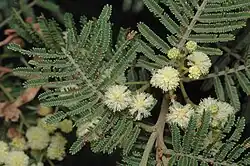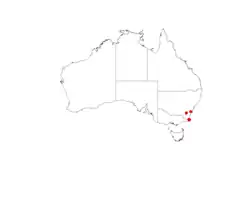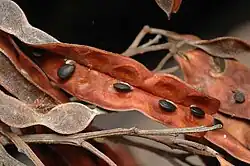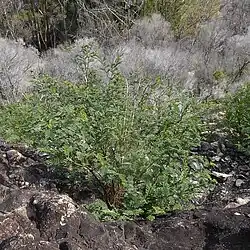Acacia constablei
| Narrabarba wattle | |
|---|---|

| |
| Scientific classification | |
| Kingdom: | Plantae |
| Clade: | Tracheophytes |
| Clade: | Angiosperms |
| Clade: | Eudicots |
| Clade: | Rosids |
| Order: | Fabales |
| Family: | Fabaceae |
| Subfamily: | Caesalpinioideae |
| Clade: | Mimosoid clade |
| Genus: | Acacia |
| Species: | A. constablei
|
| Binomial name | |
| Acacia constablei | |

| |
| Occurrence data from AVH | |
| Synonyms[2] | |
|
Racosperma constablei (Tindale) Pedley | |


Acacia constablei, commonly known as the Narrabarba wattle,[3] is a species of flowering plant in the family Fabaceae and is endemic to a restricted part of New South Wales, Australia. It is a straggling or erect shrub with smooth bark, knobbly branchlets, bipinnate leaves with 6 to 14 pairs of pinnae, each with 9 to 30 pairs of more or less oblong or narrowly oblong pinnules, spherical heads of pale yellow or cream-coloured flowers, and straight to slightly curved, leathery pods.
Description
Acacia constablei is an erect to straggling shrub that typically grows to a height of 1–3 m (3 ft 3 in – 9 ft 10 in) but can be as tall as 7 m (23 ft). It has smooth grey, often mottled bark and dark grey branchlets with knobbly ridges. Its leaves are bipinnate, thick, leathery and dark green, on a petiole up to 10 mm (0.39 in) long, the rachis 17–50 mm (0.67–1.97 in) long with mostly 6 to 19 pairs of pinnae, each with 9 to 30 pairs of oblong to narrowly oblong closely-spaced pinnules 1–2.5 mm (0.039–0.098 in) long and 0.5–0.8 mm (0.020–0.031 in) wide. The flowers are borne in spherical heads in racemes in leaf axils, on a peduncle 2–6 mm (0.079–0.236 in) long, each head 5–7 mm (0.20–0.28 in) in diameter with 30 to 45 pale yellow or cream-coloured flowers. Flowering usually occurs between June and August and the pods are flat and straight to curved, 30–70 mm (1.2–2.8 in) long and 7–10 mm (0.28–0.39 in) wide, dark brown to black and covered in short fine hairs.[3][4][5][6][7][8][9]
Taxonomy
Acacia constablei was first formally described in 1980 by the Mary Tindale in the journal Telopea from specimens collected on a hill south-east of Narrabarba in the Mount Imlay National Park.[4][10] The specific epithet honours Ernest Francis Constable, who was once the botanical collector for the Royal Botanic Gardens, Sydney.[7]
Distribution
Narrabarba wattle has a limited distribution about 20 km (12 mi) south of Eden in south western New South Wales with the bulk of the population confined to the Nadgee State Forest and within the boundaries of the proposed Narrabarba Hill Flora Reserve over a range of about 3 km (1.9 mi). Another smaller population in situated in Beowa National Park. The species is found on rocky rhyolite and apatite ridge-tops with nutrient poor skeletal sandy soils but sometimes in brown to black loamy soils. The estimated population is about 6,000 individuals in an area of around 4 ha (9.9 acres).[1][7][8]
Conservation status
Acacia constablei is listed as "critically endangered" under the Australian Government Environment Protection and Biodiversity Conservation Act 1999 and the New South Wales Government Biodiversity Conservation Act 2016.[8]
See also
References
- ^ a b Acacia constablei, Species Profile and Threats Database, Department of the Environment and Heritage, Australia.
- ^ a b "Acacia constablei". Australian Plant Census. Retrieved 22 July 2025.
- ^ a b Kodela, Phillip G.; Tindale, Mary D. Kodela, Phillip G. (ed.). "Acacia constablei". Flora of Australia. Australian Biological Resources Study, Department of Climate Change, Energy, the Environment and Water: Canberra. Retrieved 22 July 2025.
- ^ a b Tindale, Mary D. (1980). "Notes on Australian taxa of Acacia No. 6". Telopea. 1 (6): 429–432. Retrieved 22 July 2025.
- ^ "Acacia constablei". World Wide Wattle. Retrieved 22 July 2025.
- ^ "Acacia constablei". Australian Biological Resources Study. Retrieved 22 July 2025.
- ^ a b c "Acacia constablei". Royal Botanic Garden, Sydney. Retrieved 22 July 2025.
- ^ a b c "Narrabarba Wattle - profile". New South Wales Government, Office of Environment and Heritage. Retrieved 22 July 2025.
- ^ "Conservation Advice for Acacia constablei (Narrabarba wattle)" (PDF). Australian Government Department of Climate Change, Energy the Environment and Water. Retrieved 22 July 2025.
- ^ "Acacia constablei". APNI. Retrieved 22 July 2025.
